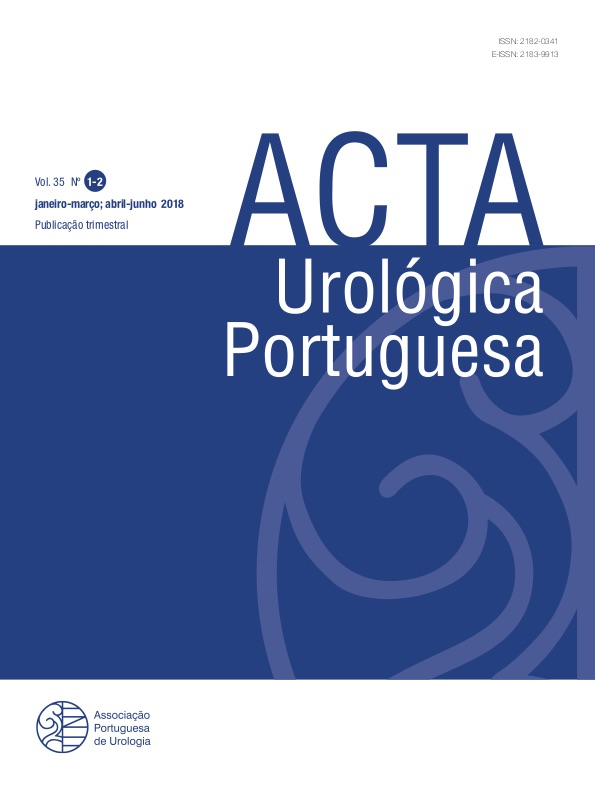Estudo Comparativo da Eficácia e Segurança entre 2 Instrumentos de Energia Bipolar (EnSeal® e LigasureTM) na Selagem Vascular em Modelo Suíno Ex-Vivo
DOI:
https://doi.org/10.24915/aup.35.1-2.79Palavras-chave:
Hemostase Cirúrgica, Modelos Animal, Procedimentos Cirúrgicos Vasculares, Procedimentos Endovasculares, SuínoResumo
Introdução: A hemostase é uma questão central na cirurgia laparoscópica. Não há diretrizes claras quando se trata de escolher qual o instrumento de energia a utilizar. Este estudo compara a eficiência e segurança entre EnSeal® e LigasureTM na selagem de artérias e veias em um modelo porcino ex-vivo.
Métodos: Os instrumentos foram comparados entre si em relação à velocidade de corte e à pressão de ruptura (burst pressure - BP) após a colheita do vaso. Os níveis de coagulação e corte dos geradores foram configurados a um nível constante de energia. Um grupo de vasos foi enviado para análise histológica para avaliação do dano térmicos e selagem histológica.
Resultados: Foram testados 124 vasos. No geral, o LigasureTM foi o instrumento mais rápido em todos os tipos de vasos e o EnSeal® foi o mais lento. Não houve diferenças estatisticamente significativas entre a BP, exceto para o grupo de artérias médias, onde a BP gerada pelo LigasureTM foi significativamente maior que a gerada pelo EnSeal®. No mesmo grupo de vasos, o LigasureTM foi o que apresentou a menor porcentagem de falhas de selagem. Não houve associação entre o número de falhas de selagem e o tamanho do vaso. Houve, no entanto, uma associação entre o número de falhas de selagem nas artérias versus veias, com maior número de falhas nas artérias em ambos os instrumentos, em comparação com nenhuma falha nas veias com LigasureTM. Embora não tenham sido encontradas diferenças estatisticamente significativas entre as selagens dos dois instrumentos, aquele com maior comprimento médio de selagem nas artérias e nas veias foi o LigasureTM, o que teoricamente pode significar uma selagem mais confiável.
Conclusão: O LigasureTM fornece a selagem mais rápida e confiável, com BP superior em artérias médias comparativamente ao EnSeal® e com maior comprimento de selagem, tanto nas artérias como nas veias. No entanto, apresentou danos térmicos significativamente maiores que o EnSeal®.
Downloads
Referências
2. Bibi S, Alblawi S, Velchuru V, Thripuraneni G, Quinteros F, Coralic J, et al. Sealing of Vessels Larger Than 7 Millimeters Using Enseal in Porcine Aorta. JSLS J Soc Laparoendosc Surg. 2014;18(3):e2014.00182.
3. Chikamoto A, Kaida T, Arima K, Higashi T, Taki K, Ida S, et al. Heat injury to the inferior vena cava by bipolar tissue sealer. Surg Endosc. Springer US; 2015;2–5.
4. Tanaka R, Gitelis M, Meiselman D, Abar B, Zapf M, Carbray J, et al. Evaluation of Vessel Sealing Performance Among Ultrasonic Devices in a Porcine Model. Surg Innov. 2015;22(4):338–43.
5. Lyons SD, Law KSK. Laparoscopic vessel sealing technologies. J Minim Invasive Gynecol [Internet]. Elsevier Ltd; 2013;20(3):301–7.
6. Družijanić N, Pogorelić Z, Perko Z, Mrklić I, Tomić S. Comparison of lateral thermal damage of the human peritoneum using monopolar diathermy, Harmonic scalpel and LigaSure. Can J Surg. 2012;55(5):317–21.
7. Zaidi N, Glover AR, Sidhu SB. The Covidien LigaSure Maryland Jaw Device. 2015;12(2):151–5.
8. Press D. Consistency and sealing of advanced bipolar tissue sealers. 2015;193–9.
9. JF A. Laparoscopic application of an ultrasonically activated scalpel. Gastrointest Endosc Clin North Am. 1993;(3(2)):381–91.
10. Monroe EH, Pirozzi K, Schulte JB, Clymer JW. Tissue effects in vessel sealing and transection from an ultrasonic device with more intelligent control of energy delivery. 2013;151–4.
11. Heniford BT. A Comparison of Laparoscopic Bipolar Vessel Sealing. 2003;13(6).
12. Person B, Vivas D a, Ruiz D, Talcott M, Coad JE, Wexner SD. Comparison of four energy-based vascular sealing and cutting instruments: A porcine model. Surg Endosc. 2008;22(2):534–8.
13. Hruby GW, Marruffo FC, Durak E, Collins SM, Pierorazio P, Humphrey PA, et al. Evaluation of Surgical Energy Devices for Vessel Sealing and Peripheral Energy Spread in a Porcine Model. J Urol. 2007;178(6):2689–93.
14. Giglio NC, Hutchens TC, Perkins WC, Latimer C, Ward A, Nau WH, et al. Rapid infrared laser sealing and cutting of porcine renal vessels, ex vivo. SPIE 8926, Photonic Ther Diagnostics X. 2014;892619.
15. Seehofer D, Mogl M, Boas-Knoop S, Unger J, Schirmeier A, Chopra S, et al. Safety and efficacy of new integrated bipolar and ultrasonic scissors compared to conventional laparoscopic 5-mm sealing and cutting instruments. Surg Endosc. 2012;26(9):2541–9.
16. Newcomb WL, Hope WW, Schmelzer TM, Heath JJ, Norton HJ, Lincourt AE, et al. Comparison of blood vessel sealing among new electrosurgical and ultrasonic devices. Surg Endosc Other Interv Tech. 2009;23(1):90–6.
17. Mantke R, Halangk W, Habermann a., Peters B, Konrad S, Guenther M, et al. Efficacy and safety of 5-mm-diameter bipolar and ultrasonic shears for cutting carotid arteries of the hybrid pig. Surg Endosc Other Interv Tech. 2011;25(2):577–85.
18. Timm RW, Asher RM, Tellio KR, Welling AL, Clymer JW, Amaral JF. Sealing vessels up to 7 mm in diameter solely with ultrasonic technology. Med Devices (Auckl). 2014;7:263–71.




